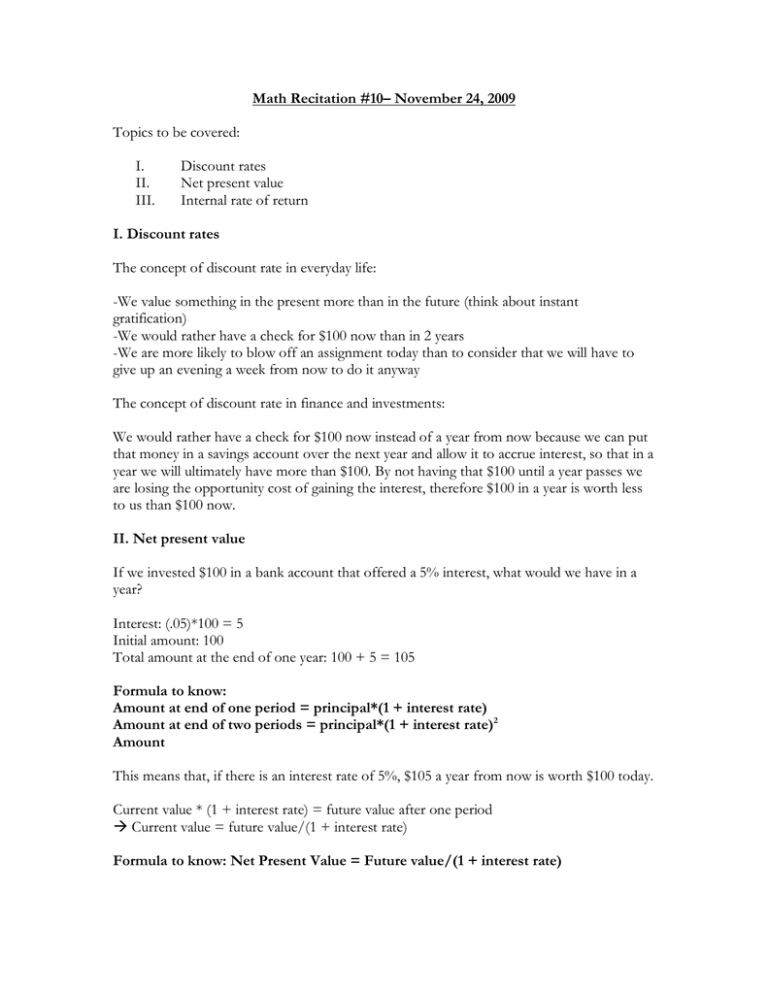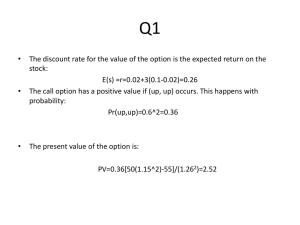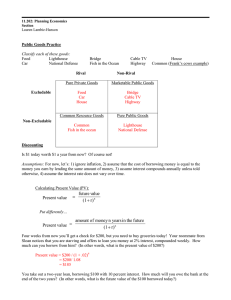Math Recitation #10– November 24, 2009 I. Discount rates I.
advertisement

Math Recitation #10– November 24, 2009 Topics to be covered: I. II. III. Discount rates Net present value Internal rate of return I. Discount rates The concept of discount rate in everyday life: -We value something in the present more than in the future (think about instant gratification) -We would rather have a check for $100 now than in 2 years -We are more likely to blow off an assignment today than to consider that we will have to give up an evening a week from now to do it anyway The concept of discount rate in finance and investments: We would rather have a check for $100 now instead of a year from now because we can put that money in a savings account over the next year and allow it to accrue interest, so that in a year we will ultimately have more than $100. By not having that $100 until a year passes we are losing the opportunity cost of gaining the interest, therefore $100 in a year is worth less to us than $100 now. II. Net present value If we invested $100 in a bank account that offered a 5% interest, what would we have in a year? Interest: (.05)*100 = 5 Initial amount: 100 Total amount at the end of one year: 100 + 5 = 105 Formula to know: Amount at end of one period = principal*(1 + interest rate) Amount at end of two periods = principal*(1 + interest rate)2 Amount This means that, if there is an interest rate of 5%, $105 a year from now is worth $100 today. Current value * (1 + interest rate) = future value after one period • Current value = future value/(1 + interest rate) Formula to know: Net Present Value = Future value/(1 + interest rate) When deciding whether to take on a project or not, cost-benefit analysis must take into account NPV calculations. If you put in a certain amount of upfront money to pay for the project and you realize monetary benefits only in the future, the monetary amount of the benefits cannot be directly compared to the monetary amount of the initial paid costs. The future benefits must be discounted. The discount rate used when making this cost-benefit calculation is the best alternative interest rate you can get on an investment. **Whenever an NPV is calculated taking into account all costs and benefits of a project and it is positive, the project is desirable to invest in. This means you get a better investment with the project than with the next best alternative. III. Internal rate of return When we put money into a bank account, we are told what the interest rate will be. By first knowing the interest rate we can calculate how much money we will have at the end of some given period of time. Alternatively, when choosing to invest in a project, stock or bond, you may have estimates of the payback in the future, but not an interest rate. You can do the reverse calculation and figure out what the internal rate of return is on your investment based on your initial investment amount and the future payback amounts. Example 1: If we paid $100 to buy a bond that will give us $500 in 5 years, we can calculate the interest rate of this particular investment: 100(1 + x)5 = 500 Solving for x we get that x = .379 = 37.9% interest rate Example 2: We can take the NPV cost-benefit calculations of any project to get the internal rate of return. If we initially invest $100 into a project and see benefits of $20 after 1 year and $50 after 2 years and $50 after 3 years: To figure out IRR, NPV of cost = NPV of benefits 100 = 20/(1+x) + 50/(1+x)2 + 50/(1+x)3 NPV of project = 0 = -100 + 20/(1+x) + 50/(1+x)2 + 50/(1+x)3 Solving for x will get us the internal rate of return of this project. You can use Excel for both Net Present Value and Internal Rate of Return calculations: • “NPV” operation: first term in formula is assumed to be paid a year from now so it is discounted • “IRR” operation: first term in formula is assumed to be paid immediately, so it is not discounted. MIT OpenCourseWare http://ocw.mit.edu 11.202 Planning Economics Fall 2010 For information about citing these materials or our Terms of Use, visit: http://ocw.mit.edu/terms.











